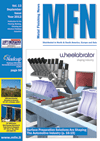E-Archive
Standards Forum
in Vol. 13 - September Issue - Year 2012
New Automated Peening Specifications from SAE

Paul Huyton
The Surface Enhancement (SE) committee of the SAE AMEC group has completely rewritten the Automated Peening Specification, AMS 2430; it is now at revision level "S". This is a significant revision, as every part of the specification has been examined and improved where required. Members of the SE committee have also introduced some new requirements or guidance based on feedback from the industry. The following is not an exhaustive analysis of the specification, but some of the principal features are described as processors will need to review their own procedures when working to this specification.
Media Inspection
The new specification gives instructions on how to undertake the media shape inspection and the type of equipment required. This was not previously provided so processors had to devise their own techniques to determine the number of unacceptable shapes in a sample. Inspection techniques that deviate from the new instructions are permitted subject to approval from the cognizant engineering authority. Importantly, the minimum magnification for the shape inspection is also defined, depending upon the size of media being inspected. The shape of acceptable media is shown in diagrams and any shape other than these is considered unacceptable. The previous revision of the specification tried to define unacceptable shapes but this could be misleading. There are so many possible unacceptable configurations that they could not all be depicted in the specification and this could have led to errors in the inspection results. The specification also requires that the shot sample is representative of media being propelled against the part and must not be altered e.g. by sieving. So the sample should be taken independently of the sample for sieve analysis. Also, taking a sample from the outflow of the screen separator is not representative unless 100% of the media passes through the separator on each cycle. The sample must be poured onto the adhesive tape or other tool used to retain the media for inspection. Dabbing of adhesive tape into a media sample may only contact the whole pieces of shot and leave damaged, unacceptable pieces behind; hence this would not be a representative sample.
Peening Machines
The basic requirements for a shot peening machine are defined but remain broad enough to permit all effective machines. Compressed air peening, centrifugal (wheel) peening and wet peening are all included. Machines using compressed air must have a low pressure alarm on the air supply system; there is no distinction between a system built-in to the machine or an alarm on the supply pipe work directly feeding the machine.
Hole Peening
Procedures for hole peening are included. Holes smaller than 13 mm do not require peening unless specifically indicated on the manufacturing drawing. External nozzles can be used for hole peening if the intensity and coverage at the resulting angle of impingement are verified as conforming to engineering requirements.
Intensity Verification
Intensity verification must be within ± .0015 inch (.0375 mm) of the value stated on process sheets and within the range for the part. Sub-size Almen strips are permitted subject to the correlation procedures in SAE J443. Just one retest is permitted if the verification does not meet requirements. If the second verification does not meet requirements and parts may be affected these must be quarantined and the customer notified of the corrective action.
Calibration
The specification states that calibration shall be carried-out, as required, on Almen gauges, shot flow/metering devices, air pressure gauges and transducers, computer-controlled monitoring equipment, and equipment controllers.
Training
The necessary training and proof of proficiency of staff involved with shot peening is defined in section four of the specification. These are similar to the Nadcap AC7117 requirements and it should not be too difficult to provide evidence that satisfies both requirements, particularly if a recognized training source such as MFN is used.
Process Sheets
The minimum content of the process sheets is defined, including the saturation curve data for the process qualification or periodic requalification.
Process Certification
The processor shall supply a report with each shipment of parts stating the processing is to requirements, including the specific intensity and coverage requirements e.g. "Peened to AMS2430S, 006-010 A intensity and 100% coverage."
Technical Guidance
Section eight of the specification contains a great deal of guidance material which can be of use to engineers and processors. This includes guidance on shot type, size and peening intensities on various materials; residual stress depths; pre-peening procedures and post-peening considerations such as temperature limitations.
Limitations
This specification is for automated peening only. The SE committee is working on independent specifications for manual peening and batch (tumble) peening.
Conclusion
AMS2430S is a major rewrite of this specification, and only a few of the requirements are mentioned in this article. Processors need to undertake a comprehensive review of the specification, which is available from the SAE website: www.sae.org.
For questions contact paul@mfn.li
Standards Forum
by Paul Huyton,
MFN Course Director World Wide
more information at www.mfn.li/trainers




























